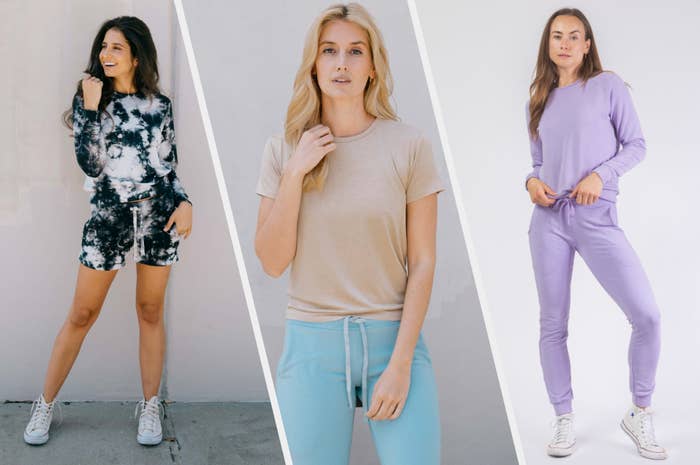How Branded Clothing Uses Fabric to Match Season and Occasion
How Branded Clothing Uses Fabric to Match Season and Occasion
Blog Article
Understanding Clothing: The Relevance of Fabric Selections in Your Wardrobe
The choice of material in clothing plays a critical function in both looks and capability. Different materials supply differing levels of sturdiness, comfort, and breathability, directly affecting the user's experience. Comprehending these subtleties can boost one's closet markedly. Yet, many forget how these choices can impact not just individual style, however additionally sustainability. What textile decisions could redefine your wardrobe and align it with both design and responsibility?
The Role of Material in vogue and Capability

Common Textile Kinds and Their Attributes
When picking clothes, recognizing the characteristics of usual textile types is essential for making educated choices. Cotton, a widely-used all-natural fiber, is recognized for its breathability, soft qualities, and flexibility, making it appropriate for informal wear and daily garments. Bed linen, an additional natural alternative, boasts superb moisture-wicking residential properties and a distinctive appearance, ideal for warm climates.Wool, frequently favored for its heat and durability, differs in excellence; merino wool is soft against the skin, while coarser kinds are used for outerwear. Synthetic materials like polyester and nylon offer longevity and resistance to wrinkles, making them preferred for activewear and traveling garments. Blends, which integrate natural and artificial fibers, can improve functionality while keeping comfort. By recognizing these material characteristics, individuals can choose apparel that straightens with their way of life and visual choices.
Breathability and Comfort: Selecting the Right Fabrics for Different Climates
Picking the ideal textiles for different climates can greatly boost convenience and overall wearability. Breathable materials are crucial in hot environments, as they permit air flow and wetness evaporation. Fabrics such as cotton, bed linen, and moisture-wicking synthetics efficiently draw sweat away from the body, maintaining the wearer cool and dry. Alternatively, in chillier climates, thicker materials like woollen or fleece offer insulation while retaining breathability, guaranteeing warmth without overheating.Additionally, the choice of material weight plays a crucial duty; lightweight materials are more effective for summertime, whereas larger choices are suited for winter months wear. Comprehending the special homes of each fabric allows people to dress suitably for varying climate condition. Inevitably, selecting comfortable and breathable fabrics customized to specific climates can considerably boost daily convenience and improve the general experience of using clothes.
Sturdiness and Care: Exactly How Fabric Influences Long Life of Your Closet
Picking the appropriate products can considerably influence the toughness and treatment demands of a wardrobe. Fabrics such as cotton and polyester are understood for their durability and convenience of maintenance, making them ideal for daily wear. On the other hand, fragile products like silk and shoelace call for more careful handling and specialized cleansing approaches, which can enhance the time and initiative needed for care. Branded Clothing.Durability is likewise affected by the textile's weave and finish; tightly woven fabrics tend to withstand damage better than loosely woven choices. In addition, synthetic blends frequently provide improved sturdiness, integrating the very best qualities of several fibers.Understanding the care instructions for every fabric is important, as improper washing or drying out can lead to premature wear. Inevitably, selecting sturdy products can lead to a longer-lasting closet, decreasing the frequency of replacements and adding to a much more sustainable fashion selection
The Influence of Material on Fit and Shape

Lasting Textile Options: Making Eco-Friendly Decisions
The effect of textile expands beyond fit and silhouette to encompass ecological variables, motivating a growing interest in sustainable fabric selections. Eco-friendly textiles, such as natural cotton, hemp, and Tencel, are getting traction among customers that prioritize sustainability in their closets. These products are typically generated with less chemicals and water, reducing their ecological footprint.Additionally, recycled fabrics, made from post-consumer waste, offer an ingenious remedy to the textile sector's air pollution problem. Brands significantly embrace openness in their sourcing approaches, enabling customers to make discover this enlightened choices regarding their purchases.Choosing lasting textiles not just sustains honest techniques but also encourages the garment industry to take on more liable manufacturing approaches. As understanding of environmental issues increases, individuals are urged to review the long-lasting influence of their fabric selections, promoting an activity towards an extra eco aware and lasting approach to fashion.
Boosting Style: Just How Fabric Can Transform an Outfit
While numerous may concentrate on color and cut when picking an attire, the choice of fabric plays an essential duty in elevating design and improving general look. Various products share distinctive moods and messages; for instance, silk exhibits luxury and refinement, while jeans supplies an informal, unwinded ambiance. The structure and drape of a material can drastically change the shape, with structured materials giving a refined appearance and softer ones creating an extra fluid, loosened up aesthetic.Moreover, the weight of the textile affects wearability throughout seasons. Lightweight fabrics like linen and cotton are ideal for summertime, while much heavier products such as woollen and velvet supply heat and sophistication in chillier months. Understanding textile properties, such as breathability and stretch, additionally empowers individuals to make educated selections that improve comfort without jeopardizing design. Ultimately, the appropriate textile can change a clothing from ordinary to link phenomenal, making it an essential consideration in any kind of wardrobe.
Regularly Asked Concerns
Exactly how Do I Recognize the Textile Web Content of My Clothing?
To recognize fabric content, one can take a look at treatment labels, conduct melt tests for fiber recognition, or seek advice from textile swatches. These approaches help separate materials, making sure informed selections for garments care and upkeep in daily wear.
Can Fabric Option Affect My State Of Mind or Self-confidence?
Material option can greatly affect an individual's mood and self-confidence. Branded Clothing. Certain products might evoke feelings of convenience or elegance, while others can really feel limiting or uncomplimentary, inevitably affecting self-perception and psychological wellness throughout the day
What Fabrics Are Ideal for Delicate Skin?
For individuals with sensitive skin, all-natural fabrics like cotton, bed linen, and bamboo are usually advised. These materials are breathable, hypoallergenic, and much less most likely to trigger irritability, making them suitable options for convenience and skin wellness.
How Do I Effectively Wash and Look After Various Fabrics?
To effectively clean and care for various fabrics, one must take into consideration each product's details requirements, consisting of temperature setups, cleaning agents, and drying techniques, making certain long life and keeping the fabric's original qualities for excellent use.
Are There Details Fabrics for Athletic or Performance Wear?
Sports or performance wear often utilizes textiles such as nylon, polyester, and spandex. These materials are designed for moisture-wicking, breathability, and versatility, boosting motion and convenience throughout exercises while giving durability and support. Conversely, in colder climates, thicker textiles like wool or fleece provide insulation while maintaining breathability, making sure heat without overheating.Additionally, the selection of material weight plays an important duty; light-weight materials are more suitable for summertime, whereas much heavier options are suited for winter season wear. In comparison, delicate products like silk and shoelace require even more cautious handling and specialized cleaning techniques, which can raise the time and initiative needed for care.Durability is likewise pop over to this site affected by the textile's weave and coating; securely woven fabrics have a tendency to withstand wear and tear much better than loosely woven options. In comparison, rigid textiles can limit activity yet offer a timeless, polished look.Moreover, the thickness and texture of the textile can influence the visual perception of body form. The impact of material extends beyond fit and shape to include environmental variables, triggering an expanding passion in sustainable material options. The structure and drape of a material can substantially modify the silhouette, with structured textiles providing a refined appearance and softer ones creating an extra fluid, relaxed aesthetic.Moreover, the weight of the fabric influences wearability throughout seasons.
Report this page